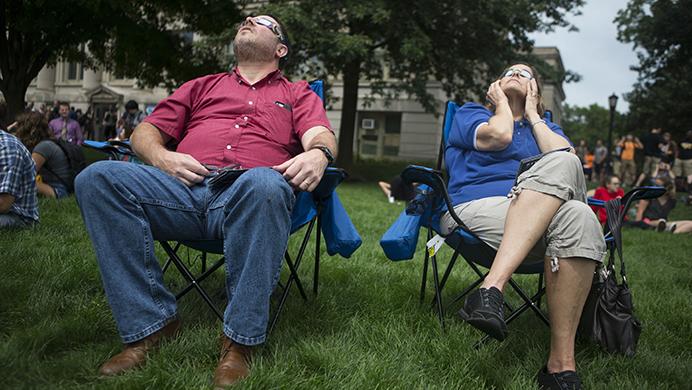On Monday afternoon, the Pentacrest lawns were flooded with activity as faculty, students, and community members camped out, donned glasses, and peered up at the sky, waiting for a rare event — a nearly total solar eclipse.
The UI Astronomy Club, UI Museum of Natural History, UI Sciences Library, and the Physics/Astronomy Department joined forces to put on a viewing event for the eclipse. Viewing stations were set up on the Pentacrest lawn and in the UI Sciences Library courtyard.
“This event is a way to celebrate the campus community coming together with everybody back for the first day of classes and watching this unique event to learn more about it,” said Liz Crooks, the communications coordinator for the Natural History Museum.
A booth was set up at each station to hand out viewing glasses for participants’ safety. Crooks said Iowa City only experienced 92 percent obscurity, but protection was still needed to experience the eclipse fully and safely. Mia Qu, the public-relations officer for the UI Astronomy Club, was one of the members handing out eye protection during the event.
Related: Iowa City prepares for solar eclipse
Qu believes that this viewing event is important not only for those who are passionate about astronomy but for all students and community members.
“This type of event doesn’t occur very often, but when it does, everyone’s excited and it’s memorable,” she said. “I think it is an event that everyone can get together and share this special moment, and I think that’s special not only for the club but for the university as well.”
Even Herky was interested — the university’s mascot made an appearance to enjoy the eclipse and take photos with spectators.
Qu said the Pentacrest and UI Sciences Library courtyard were chosen as viewing locations because of their ample seating room and expansive open sky views. She noted that the Pentacrest also provides a nice central location in the middle of campus.
The weather was the large factor in the viewing experience; the event lasted from 11:30 a.m. to 3 p.m., and skies were overcast for much of that time, partially obscuring the sun. Despite the weather, however, the eclipse was still visible near its peak around 1:15 p.m. Spectators had mixed emotions about the event; some thrilled it was still partially visible, while others were disappointed by the weather.
The UI Department of Physics and Astronomy is here to answer all your #SolarEclipse2017 questions. #Pentacrest pic.twitter.com/SY3HkuclpF
— University of Iowa (@uiowa) August 21, 2017
“I feel like if it would’ve been clear, it would’ve been way cooler,” UI student Lianna Rosa said. “It was kind of hard to find.”
Iowa City resident DeeAnn Grove disagreed.
“It was way better than I thought it was going to be,” Grove said. “We got up early and thought about driving somewhere it was sunny to watch, and I’m glad we didn’t because it was great here.”
Grove watched the last eclipse in 1979, when she was in elementary school; several decades later, she experienced the event on campus with her daughter.
Crooks said a live stream of the eclipse was put up on NASA’s website for those that were not able to make it to the viewing event or whose experience was hindered by weather.
Qu hoped the event was not only enjoyable for all those who watched but also that it helped spark interest in the field of astronomy.
“I think the most important things are that students are attracted to astronomy and the study of the universe and that they understand why this phenomenon happens,” Qu said.



